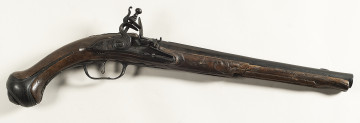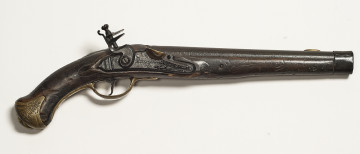
Slug iron
20th century
Castle Museum in Łańcut
Part of the collection: History of the city and the region
SINGER sewing machine with shuttle mechanism, has an engraved patent formula with the dates 1878-1887 placed on the chrome slide next to the pinion. In addition, the cast iron openwork legs bear its brand mark, while the lacquered and decorated head bears the company inscription and an oval company badge. Isaac Merritt Singer's contribution to the improvement of the sewing machine was the invention of a toothed pusher which, by slightly extending upward, moved the fabric each time after it was pierced by the needle. This innovation was introduced in 1851-1853, and brought about great popularity of the sewing machine. The first popular choice was Signer’s Model A of 1859, which offered two-threat lock stitch, as the previous machines only offered a straight stitch. The first sewing machine was built in 1755 by Ch. F. Weisental. It was large and – ultimately – unsuccessful, just like subsequent models by B. Krems (1786) and T. Saint (1790). The latter worked with one thread and made the so-called chain stitch, which easily ripped apart and used a lot of thread, although it was characterised by high flexibility. The first useful sewing machine by B. Thimonnier (1830) offered the same stitch. The problem was partially solved by E. Howe in 1845, who decided to use two threads – including one that was inserted by a needle with an eye near the point, making it into a loop. The shuttle passed through this loop and so the two-needle lock stitch was created. It had many advantages, but it was hardly flexible. In 1887, the central coil gripper replaced the shuttle, allowing twice the number of movements per minute. Despite many improvements, it was not possible to find a device that enabled moving fabric and creating curved seams, until Singer introduced his innovation. Joanna Kluz
Author / creator
Dimensions
height: 97 cm, width: 87 cm
Object type
History of the city and the region
Technique
cast, decal
Material
metal, wood, natural leather
Creation time / dating
Creation / finding place
Owner
Castle Museum in Łańcut
Identification number
Location / status

20th century
Castle Museum in Łańcut

18th century
Castle Museum in Łańcut

18th century
Castle Museum in Łańcut
DISCOVER this TOPIC
National Museum in Szczecin
DISCOVER this PATH
Educational path